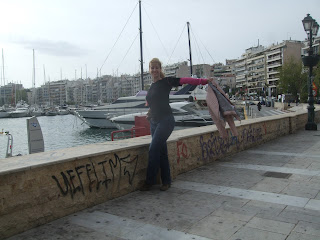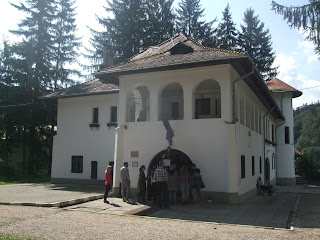We surely need a separate post to capture the vibe of Athens, beyond the main tourist attractions. And I must confess that you will not often see a city so crowded, even unexpectedly cosmopolitan, with people of all social conditions. Yet, this crowd, surprisingly, is not disturbing at all. Also, like all capital cities, Athens is full of life at all hours. The streets are full of olive and orange trees, as well as coloured flowers, still there in the month of November. Cafes, markets, shops and restaurants can be found all over the place, and the only dilemma you will have is where to go first.
If, like myself, you are going there for a few days as a fully-immersed tourist, I would advise you to buy a 2 days' pass on a hop on & hop off tourist bus, such as Athens Open Tour. A 2 days pass, bought online, cost 18 euro per person, so watch out for such special offers. The advantage is that it stops at all points of interest in the city, and you can get on and get off how many times you want, watching out for all the stopovers on the map. With the headphones offered as you get on, you can listen to the description of all the places you pass, in several languages. Speaking of which... yes, Greek looks and sounds like an impossible language, especially because of the alphabet. However, just have a go at learning some phrases, at least for fun, and to use them to find your way around. And who knows, you might even like it! :)


When you are in between archeological sites and museums, you should definitely not miss Plaka, which is one of the most ancient areas of Athens, starting from Acropolis, and ending around Monastiraki Square. Plaka is made up of pretty and narrow streets, small buildings in typical Greek architecture, with white marble and iron decorations, with all the characteristic vegetation and lively colours.
Explore the numerous shops all the way to Monastiraki Square, also one of the most important squares in the city, especially for shopping, where you can find everything you want: ceramic and clay objects, paintings and drawings, typical Greek sweets, clothes and jewels with traditional motifs, coloured leather bags, cosmetics based on olive oil and donkey milk, and the list could go on and on. Greeks like to negotiate, so definitely expect that when you go shopping. You won't buy anything (or almost) at the price displayed on the label.
Also, if you go to Monastiraki on a Sunday, be prepared to see the biggest crowd you will ever see, from the strays and homeless of the city, to rich and elegant people, locals and tourists, who enjoy a day out.
As you reach lunch or dinner time, which I'm sure you will, the Monastiraki area (and not only) will offer you a wide choice of places to eat. Obviously, Greece is famous for its cuisine, so I wouldn't even recommend that you eat somewhere else than traditional Greek restaurants and taverns. The choice of dishes is, again, very broad. But by no means should you miss moussaka, a dish based on minced meat, layered with sliced aubergines and potatoes, and topped with white sauce. Not particularly light, but delicious. :) Greek cuisine also includes souvlaki (meat skewers), traditional salad with tomatoes, cucumbers, peppers, olives and feta cheese, large seafood plates to share, and pastries of various types. Also keep an eye on traditional Greek yogurt (which is different from what you find in supermarkets in the rest of Europe), and for the best olives (both black and green) that you will ever eat.
Last but not least, as you might remember, I promised you a bonus trip. This is the neighbouring town of Piraeus, Greece's most important and ancient harbour. And actually, the tourist buses which I was telling you about also offer an itinerary towards Piraeus, so it would be a pity to miss it. Still with a very strong 'Greek' atmosphere, Piraeus is also cleaner and less crowded than Athens, and, at least on the first glance, more exclusively higher class. A relaxing town by the sea, where it will be a pleasure to sip your coffee by the shore, and last but not least, you will be left wanting an apartment and a yacht right there and then. :)
My conclusion about Athens is that it is indeed a city where history and ancient civilizations meet a dynamic world, with vibrant colours, exquisite taste, and people permanently in motion. It was a perfect birthday present, and I am looking forward to going back someday.
ευχαριστώ, Αθήνα! I will not stay away too long!




















































